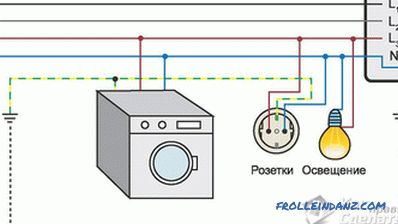The use of autonomous generators is a widespread practice - in general, these are fairly simple devices and there are no problems with their acquisition. The more acute is the question of which generator to choose for a house or a dacha, because improperly chosen characteristics of the equipment will at best entail an excessive cost of its operation, and at worst an inability to perform its functions and breakdown from systematic overload.
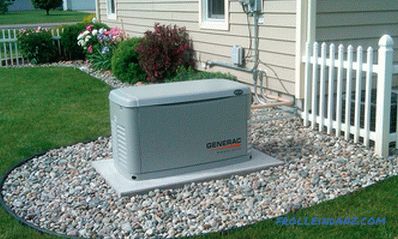
Types of engines of independent generators
Internal combustion engines are primarily divided into two and four-stroke. The principal difference for the user is that in order to “feed” a two-stroke, he will have to prepare a mixture of fuel and oil, and in four-stroke it is just to add gasoline (or diesel) - this engine also consumes oil, but it is poured separately and is not ejected with exhaust gases.
Two-tactics are low-power generators - 1-5 kW, and in rare cases up to 10.

This may be enough for self-contained power supply at home without a large the number of electrical appliances, so there is a chance to encounter a two-stroke engine when choosing, although in general for power at home its advantages look somewhat ghostly and the choice is much more likely to fall on four-stroke ones.
The next item is the type of fuel used by the engine - gas, diesel or gas. It should be remembered that gas engines are converted to work on gas, so you can switch between these types of fuel.
Autonomous generators with a gasoline engine
Gasoline engines are rightly the most common in home-class generators, as they have a number of advantages that level out disadvantages that are not particularly critical for home use. First of all, it is the price, which is 2-3 times lower than the diesel analogue with similar characteristics. Next comes the ability to run without any difficulties in cold weather up to 20 ° C, and sometimes higher. Finally, the sound of such engines is quieter than that of diesel engines, and the engine itself is capable of operating at minimum speed (the diesel engine needs a minimum load, at least 40% of the nominal value).
At the same time, only a relatively small lifespan (within 4-5 thousand hours) and a low limit of the maximum generator power (15 kW) can be attributed to gasoline minuses - theoretically it can be created and more powerful, but it is more economical to use diesel engine.
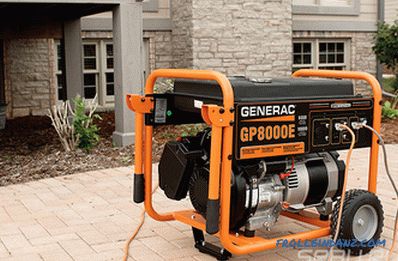
Autonomous gas-powered generators
Using gas reduces the cost of fuel and increases the overall durability of gasoline engines, as the combustion products have much less soot . If the gas line approaches the house, then this is almost an ideal option, because the gas is turned off much less frequently than electricity.
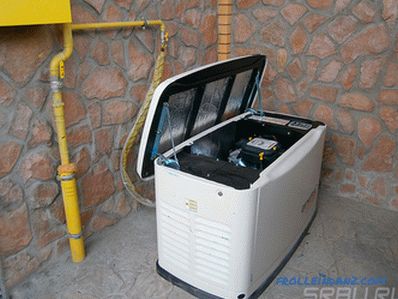
Diesel Autonomous Generators
Diesel internal combustion engines are more expensive to produce and heavier, but more economical and more durable, therefore they are used for stand-alone power plants of high power or when required increased efficiency and reliability. Particularly relevant are these requirements, if necessary, to power powerful current consumers in a round-the-clock or simply continuous mode.
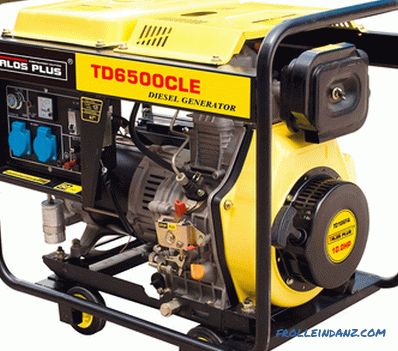
How to determine the type of generator
The second name for this part of the generator is the alternator. It is he who is directly responsible for generating electricity, converting the mechanical energy of rotation of the motor shaft into electrical energy.
There are two main types of generators, which got their name from the corresponding types of electric motors, taken as their basis - synchronous and asynchronous. If you do not go into the technical details, then basically for the average user the difference will be in the simplicity of the service and the quality (stability) of the electricity produced.
Asynchronous generator
As the simplicity of maintenance, asynchronous generators were unquestionably in the lead, because their rotor is short-circuited, i.e. it has no additional winding. This means that the inside of the asynchronous unit does not need to be further cooled - to make additional ventilation holes in the stator, through which dust and moisture also enter. The only service that might be needed over time is to replace the bearings or simply update the lubricant for them. Also to the advantages of asynchronous generators, you can write a "friendship" with the short circuit mode (they show themselves better when working with welding machines).
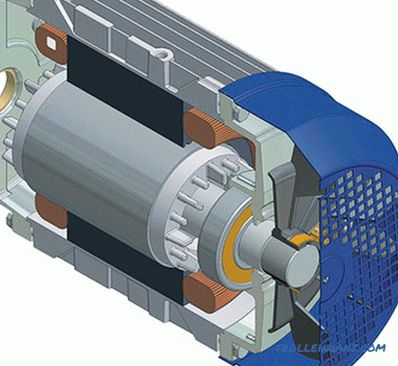
Synchronous generator
As to the quality of the generated electricity, synchronous generators showed themselves better - they have a much smaller dependence of the output voltage on the engine speed ( for asynchronous, it is linear, and synchronous give the specified voltage even with some deviations).Also, synchronous generators show themselves much better under conditions of constantly varying loads and without special consequences they withstand short-term overloads (asynchronous, in this case, the risk of demagnetization of the armature is high).
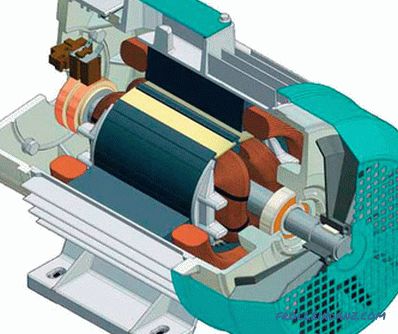
As a result, asynchronics show the best results only if they are used for welding. If you need to choose a generator to give or at home, in most cases a synchronous type of generator is preferable, even despite the need for periodic replacement of brushes and a higher total cost. An additional trump card is the appearance of brushless synchronous generators with a squirrel-cage rotor, which are gradually replacing asynchronous models.
If you need to power the exact equipment, you should pay attention to the generators with inverter voltage generation. In such devices, the generated current is rectified, conducted through the stabilizer, and then converted back to alternating. As a result, the error of the output voltage is only 1% of the nominal, whereas in any other scheme it is about 5%.
Start-up systems for an independent generator
Only two generator start-up systems are used in principle - manual and automatic. The starter of the first of them is driven by a cable that you have to pull manually, but first you need to switch the power, turn off the main line, and then start the engine.
Automatic start is performed using a fairly complex system, because besides directly spinning up the starter, you need to perform a number of additional actions:
- Monitoring the presence of voltage in the main network. When it disappears, a command is issued to activate the generator.
- Switching the power supply of the house from the main line to the generator so that when there is electricity there is no countercurrent that is guaranteed to burn the winding.
- Every motorist knows that a cold engine should be started with a closed air damper. If the generator works autonomously, then a block is needed closing the valve before starting and opening it after the engine is warming up.
- Starter start.
- When voltage appears on the main line, the generator engine is muffled, and the house power is switched back.
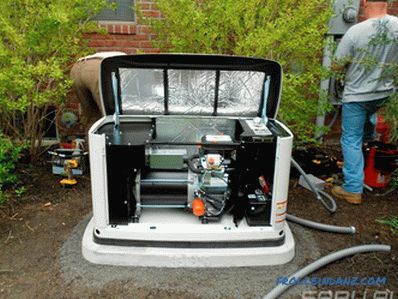
As a result, if you need a generator capable of fully autonomous operation, you must select a device with an automatic start system. The launch system can be quite a significant part of the cost of all equipment.
Additional elements
Usually, all additional equipment is designed to increase the safety and convenience of working with the generator. Part of it can be installed in the manufacture of the device or added to the store (sometimes held promotions), and the rest can be purchased at will.
First of all, these are safety devices - fuses and circuit breakers, which, after switching off, can be switched on again manually or automatically (depending on the generator class).
Drop sensor - it is still installed from the factory on most generators, except for the smallest ones (they are also not needed on two-stroke engines).
Indicators - lamp, arrow or LED. Show information about the status of the oil level, signal the appearance of an overload, or simply display the current mode of operation.
The hour meter - seriously facilitates the monitoring of the time remaining until the next major overhaul or just engine maintenance. Often present in the factory assembly.
A voltmeter — useful for connecting a large load — indicates if the generator starts to work incorrectly. It is considered a mandatory part, but on the most low-powered devices it may still be absent - eminent manufacturers often sin on this, as if emphasizing confidence in their products.
Fuel tank with fuel gauge and drain cock. As far as the last two parts are necessary, each decides for himself, but the tank as a whole determines how much time the generator is able to work without refueling. If this is a frame-type device, then they generally try to install the tank on it for the entire length of the frame. It is also necessary to take into account that since gasoline devices often need interruptions in work, an appropriate tank volume can be selected for them - if the fuel is over, it means that the generator should be allowed to rest.
Sockets are single and three phase. Their presence is not regulated by anything and completely depends on the manufacturer. It may be an option when there are ordinary and power sockets - if there is no experience to distinguish them "by eye", then it is better to study the documentation for the generator, where it should be indicated to which outlet that can be connected.
12 Volt Output - for which make clamping terminals, socket or a separate outlet. According to users, most often the presence of such a conclusion pleases motorists, since it is convenient to recharge batteries from it. For other purposes, it is better not to use it, because devices that need 12 Volt of power to operate are usually sensitive and should not be connected directly to the generator.
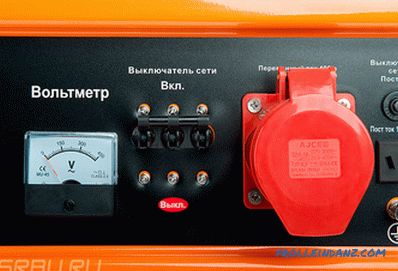
Number of phases of the generator
It is very simple to make a choice between one and three-phase generator - if you need to connect three-phase power consumers, the appropriate device is selected, and if there is only single-phase devices - single-phase generator.
In some cases, for a single-phase network, they try to install a three-phase generator, guided by the consideration that it is possible to “scatter” the phases along different lines. This can really be done, but only under one important condition - if approximately the same load “hangs” on each phase - the difference in power should not exceed a maximum of 30%. This means that if the two phases of the 15 kW generator are not occupied, then the third can turn on a maximum of 5 kW. In this case, the generator itself will not work in nominal mode, and over time there is a big risk of its failure.
In a private house, it is almost impossible to achieve a uniform load distribution, so if the vast majority of devices are single-phase and one or two are three-phase, then you must either purchase an additional generator, or change the appliances themselves to single-phase ones, or not these devices when power is supplied to the house from the generator.
Selection of generator power
It may seem to the non-initiate user that there should not be any particular difficulties in choosing a petrol generator to give power. This is a simple mathematical task — if it is stated on the generator that it can produce, for example, 10 kilowatts, then it is at the same time that such total power can be hung on it. Some may even take into account that the generator needs some “margin of safety”, subtract 20-30% from the maximum power and assume that everything has been correctly calculated. In practice, everything is somewhat more complicated and for a competent calculation it will be necessary to take into account an additional series of nuances.
Power reserve
Oddly enough, but many forget about this truism or simply try to save on the choice of a more powerful generator to provide the same 20-30% of the power reserve. As a result, the generator can operate for wear, which drastically reduces its service life.
An unpleasant surprise can also throw an asynchronous generator, which, although immune to short-circuit currents, is extremely sensitive to overloads, even short-term ones. The fact is that its launch and operation provides the residual magnetic field of the armature - after the generator stops, the rotor retains some magnetization, which is enough to induce an emf on the stator windings during the next start of the device. At the moments of peak overloads, the magnetic field of the armature simply disappears and the generator ceases to generate current, although the motor continues to rotate. In this case, it is necessary to forcibly magnetize the rotor - although this is a simple procedure, but the need to repeat it at times of overloads is quite unpleasant for the user.
Also, the power reserve is needed to power the electrical appliances with electric motors, which need a current 2-3 times greater than the nominal power.
Active and reactive power (volt-amperes and coefficients)
The simplest example, when it may appear that the generator is faulty, occurs in the case of unaccounted reactive power of electrical equipment. In simple words, it can be called a parasitic phenomenon, when part of the power is spent not on the work of an electrical device, but on losses (heat generation, etc.).
Without plunging into the jungle of electrical engineering, an ordinary user needs to know that any electrical appliance that has an electric motor has reactive power — a phase shift occurs in its windings and additional power losses occur. Therefore, the power here is determined by the product of the current and voltage relative to the power factor (Cos φ), which is different for each device and can be from 0.3 to 1 (the more, the less loss).
The same applies to the generator itself - since it is essentially an electric motor, it has its own coefficient, which is usually 0.8 (although there may be other values). This means that if the generator has a power of 15 kW, then this is an active component, and if you connect a reactive load, you will have to take into account the coefficient and you will end up with 15 * 0.8 = 12 kW (multiplication, not division by factor, is done, as a generator the current is generated) and this is without taking into account the coefficients of powered appliances.
Also calculated and the actual power of electrical appliances. For example, there is a vacuum cleaner with a passport power of 1000 W and a coefficient of 0.6. In this case, it will take from the generator not 1 kW, but 1000 / 0.6≈1.7 VA (Volt-Amp). Such calculations do not have to be carried out, if the manufacturers initially indicated power instead of the usual kW in Volt-Amperes, although if part of the equipment is marked with kilowatts and the other with volt-amperes, then it will be necessary to practice translations between measurement systems.
As a result, if the equipment does not specify exact values in the form of Volt-Amps and Cos φ, then the easiest thing to add to the power of electrical appliances with electric motors is 50% and this value is used in the calculations.
Capacitive load
The concept of capacitive load is most often encountered by professional photographers - it is they who can use lighting devices based on discharge lamps or the like at the exit.
The very nature of obtaining the capacitive component of the electric current involves the use of an asynchronous generator, since it gives out voltage in a “soft” way - the stator field rotates after the rotor.
Using a generator to power a house or give it
When choosing a generator for a private house, one of the main questions will be understanding how it will be used - as a backup or permanent source of electricity. Only if you know the exact answer to this question, you can choose the type of engine, power of the inventory and decide whether to take a quality brand device or a budget Chinese model.
In any case, if you need a generator for the whole house, even if it is just a dacha, it makes no sense to look towards portable models with a power of 0.8-1.5 kW. They are only enough for lighting and TV, and even a low-power refrigerator can cause an overload on startup.
You also need to be ready to allocate a separate room to the generator and it’s very good if you can make sound insulation and heating there. The last question is especially important when you need to use a diesel engine.
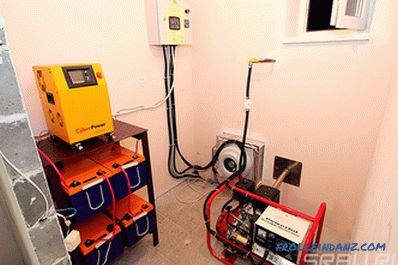
Ready-made solutions are becoming increasingly popular, in which a gasoline, gas or diesel generator is enclosed in a special case. Such power plants are mounted on a concrete platform near the house. If funds allow, it is better to give preference to such systems, since these are the most practical, convenient and reliable devices.

If necessary, you can make a similar container yourself. Below you can see an example of a similar structure made of profiled sheeting.
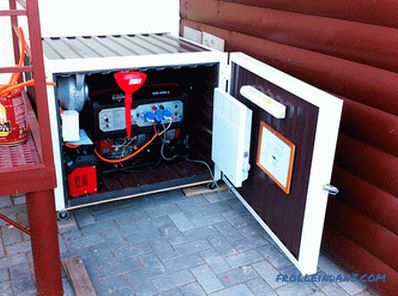
And one of the main questions is how to connect the generator to the home network. For this purpose, only switches of the "or-or" type are suitable - they completely exclude the possibility of electric current from the main power supply line to the generator windings, which leads to their burning out without any options.
Using a generator as a backup or emergency source for a residential house
If electricity on the main line is turned off only occasionally, then you can congratulate yourself on the opportunity to save. Besides the fact that there is no special need to acquire a powerful generator, a Chinese-made device with a gasoline engine is quite suitable for this purpose. The resource of such a generator is about 1-1.5 thousand hours and if you run it once a week for 3-4 hours, then it is easy to calculate that it will be enough for 12-15 years.
Another question is if the electricity is turned off almost daily (it makes no sense to think where the power supply organizations are looking at - more often the problem will be solved faster on their own) - in this case it is more profitable to purchase a branded generator. Even devices with a gasoline engine from a trusted manufacturer have a lifespan of 4-5 thousand hours.
The next item to save will be the engine start device - if the electricity is turned off from time to time, you can turn on the generator manually. Of course, it takes some time, but it eliminates the need to overpay for a separate automatic launch system. However, the decision about the need to use it in any case must be taken on the spot.
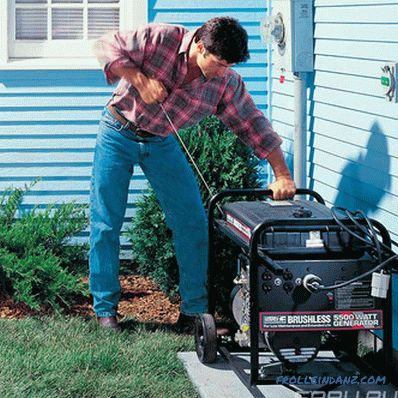
Also, when using the generator to turn on manually, it is imperative to take care of the system for signaling the appearance of electricity in the main network. To do this, you can hold a separate line in the room of an ordinary light bulb, which will turn on past the generator - when it lights up, it means you can switch to a common line.
Using a generator as a permanent source of electricity
If the use of generators with gasoline engines is more economically justified as a backup source, you will have to choose from diesel-powered models and from proven manufacturers of such equipment.
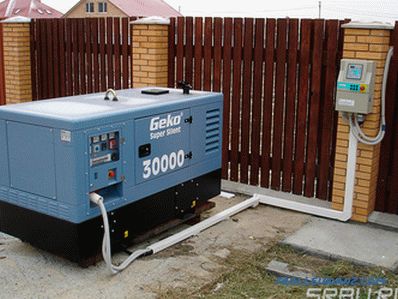
Since the generator will work practically without interruptions, it is imperative to pay attention to the presence of water cooling in it - this complicates and makes the whole structure heavier, but for a stationary device far from the most critical factor.
It is also necessary to carefully address the issue of device power selection - if there are no skills to calculate active and reactive power, then this matter is better to be entrusted to specialists. Even if the generator seller is not able to advise on this topic and the service will be ordered for a fee on the side - it will pay off in any case.
Most likely, to work as a constant current source, it makes no sense to purchase a generator with an automatic start system. In this case, the need for it is a rare exception, and if you suddenly need it, you can always install it separately.

